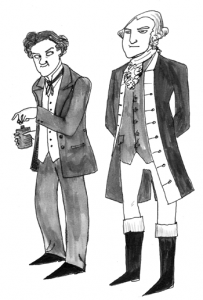Keep in mind none of you have to read this (Erika excepted). In fact, maybe it’d be better if you didn’t. (Erika not excepted)
Preamble (feel free to skip)
I refuse to quote Foucault in my analysis of the Indian Act (1876).
“But aren’t you just allowing Foucault to shape your system of knowledge-production-through-discourse per absentiam?!” Yes, yes, I know, I just don’t care.
Foucault would be particularly useful in analyzing the Act’s creation of racial categories. I’ve just had to deal with it in almost every article in the last year (not an exaggeration) and I’m feeling constrained; I doubt I’ll be able to fully escape, but vive la résistance. On that note – categories don’t spring from nowhere. Someone has to write that legislation, and while they may be produced beforehand by something else, they are anthropogenic. It does us no good to play chicken-and-egg.
Terms I won’t use: knowledge production, discourse, agency, etc., etc..
Also, in my analysis, the ‘state’ is not a governed group of people but instead the (colonial) government. I’d say they held a monopoly over the legitimate use of force in a territory (Weber, I think) but ‘legitimate’ is a bit much for me.
With the above (perhaps ridiculous) constraints in mind, let’s press forward.
“The great aim of our legislation has been to do away with the tribal system and assimilate the Indian people in all respects with the other inhabitants of the Dominion as speedily as they are fit to change.”
– John A. Macdonald, 1887
Start Reading Here
The Indian Act of 1876 is a unilateral federal policy that defines who is ‘Indian’ under Canadian law, governs the operation of bands and reserves and dictates the manner in which the Canadian government interacts with First Nations. It did away with direct engagement between aboriginal people and the state – inserting itself between them – and forbid ‘status Indians’ from taking others to court (this provision was lifted in 1951, along with the potlatch ban). The Act (consolidating Acts of ‘civilization‘ and ‘enfranchisement‘) was intended to compel the First Nations to renounce the status it assigned and join Confederation as agricultural / sedentary / Christian / propertied (non-communal) citizens. This objective (compulsory for adult males until 1967) was only voided in 1982; only one person voluntarily enfranchised.
The reserves created under the Act are a direct result of the drive for ‘civilization’ and were ostensibly meant to introduce the First Nations to sedentary agriculture, Christianity and a private-property economy. It has been argued that the “underlying motive for setting aside small tracts of land for Aboriginal peoples was to make available to newcomers the vast expanses of land outside reserve borders” (Erin Hanson); I find this argument quite persuasive.
The Act treated the First Nations as children and conferred foreign categories of sex and gender upon them to be used as mechanisms of control. Sexual orientation was not an identitarian marker (unlike dress, occupation, behaviour), but it was useful for colonization. The Act also sought to organize kinship models of relations into familial models, and excluded many people from ‘status’ – notably the Métis, Inuit and ‘non-status Indians’. The patrilineal inheritance of ‘status’ (note the gendered discrimination here) interfered directly with matrilineal systems of culture – inheritance, governance – and these provisions were lifted in 1985 so as to restore status to many who’d lost it under the patriarchal system.
I still cannot gain status despite two clear matrilineal lines of inheritance (not that I’ve tried). Even given the opportunity I prefer not to take part; I identify as First Nations and Canadian and have never felt a need to seek state acknowledgment of either. (Is this what decolonization feels like?) In fact, sometimes I think Trudeau might have had it right in ’69. Cue outrage.
The potlatch ban of 1884 was a cultural weapon of massive import. Media come into play here – the potlatch was a transmissive space for oral history, not to mention the redistribution of wealth. When it was challenged, the government instituted Section 141, preventing Indians from hiring counsel and therefore from legal recourse. This did not change until 1951, after the revelations of the Holocaust and WWII (disrupting fictive civility, I think).
I submit that the Indian Act and its amendments have been a cultural weapon, a tool of colonization and that even today they amount to apartheid. I would further submit that the Act should be kept in place (as it does enshrine certain rights and gives First Nations some political capital) until such time as legislation agreeable to all parties can be designed. While the Indian Act was meant to produce a ‘civil’ nation (Coleman’s fictive nation-building) it serves today to remind us of the brutality the Canadian state (and church – they were fairly synonymous, especially in Québec until the 70s) exerted on the First Nations.
not mentioned: residential schools (probably deserves its own blog), native identity, gender (to the substantive extent it deserves. just read Lawrence)
Worth taking a look at:
The Royal Commission on Aboriginal Peoples, 1996
The Act itself
Bonita Lawrence’s 2003 article (especially for the insights on American practices). For that matter, any of us unfamiliar with Manifest Destiny, Andrew Jackson and the Trail of Tears should have a look at those immediately. I found Canadian high schools to be pretty lacking in terms of American history, which is really quite embarrassing.
This (extremely helpful) UBC resource by Erin Hanson





